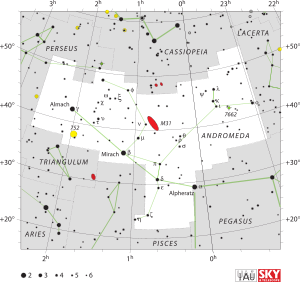Tau Andromedae
 | |
| Observation data Epoch J2000 Equinox J2000 | |
|---|---|
| Constellation | Andromeda |
| Right ascension | 01h 40m 34.81645s[1] |
| Declination | +40° 34′ 37.3742″[1] |
| Apparent magnitude (V) | +4.94[2] |
| Characteristics | |
| Spectral type | B5 III[3] |
| U−B color index | -0.41[2] |
| B−V color index | -0.09[2] |
| Astrometry | |
| Radial velocity (Rv) | -14[4] km/s |
| Proper motion (μ) | RA: +15.99[1] mas/yr Dec.: -23.76[1] mas/yr |
| Parallax (π) | 4.58 ± 0.25[1] mas |
| Distance | 710 ± 40 ly (220 ± 10 pc) |
| Details | |
| Luminosity | 851[5] L☉ |
| Surface gravity (log g) | 3.357[6] cgs |
| Temperature | 13,026[6] K |
| Rotational velocity (v sin i) | 80[7] km/s |
| Other designations | |
| Database references | |
| SIMBAD | data |
Tau Andromedae (τ And, τ Andromedae) is the Bayer designation for a star in the northern constellation of Andromeda. It has an apparent visual magnitude of +4.94,[2] which is bright enough to be viewed from dark suburban skies. From parallax measurements made during the Hipparcos mission, the distance to this star can be estimated as roughly 710 light-years (220 parsecs) from Earth. The brightness of this star is diminished by 0.24 in magnitude due to extinction caused by intervening gas and dust.[3]
The spectrum of this star matches a stellar classification of B5 III,[3] with the luminosity class of III indicating that this is a giant star. It is radiating about 851 times the luminosity of the Sun.[5]
Naming
In Chinese, 天大將軍 (Tiān Dà Jiāng Jūn), meaning Heaven's Great General, refers to an asterism consisting of τ Andromedae, γ Andromedae, φ Persei, 51 Andromedae, 49 Andromedae, χ Andromedae, υ Andromedae, 56 Andromedae, β Trianguli, γ Trianguli and δ Trianguli. Consequently, τ Andromedae itself is known as 天大將軍七 (Tiān Dà Jiāng Jūn qī, English: the Seventh Star of Heaven's Great General.).[9]
References
- 1 2 3 4 5 van Leeuwen, F. (November 2007), "Validation of the new Hipparcos reduction", Astronomy and Astrophysics, 474 (2): 653–664, arXiv:0708.1752, Bibcode:2007A&A...474..653V, doi:10.1051/0004-6361:20078357.
- 1 2 3 4 Johnson, H. L.; et al. (1966), "UBVRIJKL photometry of the bright stars", Communications of the Lunar and Planetary Laboratory, 4 (99), Bibcode:1966CoLPL...4...99J.
- 1 2 3 van Belle, Gerard T.; von Braun, Kaspar (April 2009), "Directly Determined Linear Radii and Effective Temperatures of Exoplanet Host Stars", The Astrophysical Journal, 694 (2): 1085–1098, arXiv:0901.1206, Bibcode:2009ApJ...694.1085V, doi:10.1088/0004-637X/694/2/1085.
- ↑ Wilson, Ralph Elmer (1953), General Catalogue of Stellar Radial Velocities, Washington: Carnegie Institution of Washington, Bibcode:1953GCRV..C......0W.
- 1 2 van Belle, G. T.; et al. (May 2008), "The Palomar Testbed Interferometer Calibrator Catalog", The Astrophysical Journal Supplement Series, 176 (1): 276–292, arXiv:0711.4194, Bibcode:2008ApJS..176..276V, doi:10.1086/526548.
- 1 2 Soubiran, Caroline; et al. (2016), "The PASTEL catalogue: 2016 version", Astronomy & Astrophysics, 591: A118, arXiv:1605.07384, Bibcode:2016A&A...591A.118S, doi:10.1051/0004-6361/201628497.
- ↑ Abt, Helmut A.; Levato, Hugo; Grosso, Monica (July 2002), "Rotational Velocities of B Stars", The Astrophysical Journal, 573 (1): 359–365, Bibcode:2002ApJ...573..359A, doi:10.1086/340590.
- ↑ "* tau And". SIMBAD. Centre de données astronomiques de Strasbourg. Retrieved 2012-06-24.
- ↑ (in Chinese) AEEA (Activities of Exhibition and Education in Astronomy) 天文教育資訊網 2006 年 7 月 10 日